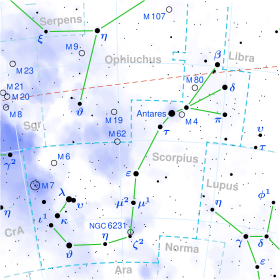| Observation data Epoch J2000 Equinox J2000 | |
|---|---|
| Constellation | Scorpius |
| Right ascension | 16h 50m 09.8s[1] |
| Declination | –34° 17′ 36″[1] |
| Apparent magnitude (V) | +2.310[2] (2.24 - 2.35)[3]) |
| Characteristics | |
| Spectral type | K1 III[4] |
| U−B color index | +1.147[2] |
| B−V color index | +1.150[2] |
| Variable type | suspected[3] |
| Astrometry | |
| Radial velocity (Rv) | –2.5[5] km/s |
| Proper motion (μ) | RA: –614.85[1] mas/yr Dec.: –255.98[1] mas/yr |
| Parallax (π) | 51.19 ± 0.22 mas[1] |
| Distance | 63.7 ± 0.3 ly (19.54 ± 0.08 pc) |
| Absolute magnitude (MV) | 0.78 ± 0.04[6] |
| Details | |
| Mass | 1.31[7] M☉ |
| Radius | 12.6[8] R☉ |
| Luminosity | 60[7] L☉ |
| Surface gravity (log g) | 2.34[7] cgs |
| Temperature | 4,560[9] K |
| Metallicity [Fe/H] | –0.17[9] dex |
| Rotational velocity (v sin i) | 2.6 ± 0.5[10] km/s |
| Age | 3.92[7] Gyr |
| Other designations | |
| Database references | |
| SIMBAD | data |
Epsilon Scorpii (ε Scorpii, abbreviated Eps Sco, ε Sco), formally named Larawag /ˈlærəwæɡ/,[12] is a star in the southern zodiac constellation of Scorpius. It has an apparent visual magnitude of +2.3,[2] making it the fifth-brightest member of the constellation. Parallax measurements made during the Hipparcos mission provide an estimated distance to this star of around 63.7 light-years (19.5 parsecs) from the Sun.[1]
Epsilon Scorpii has a stellar classification of K1 III,[4] which indicates it has exhausted the supply of hydrogen at its core and evolved into a giant star. The interferometry-measured angular diameter of this star, after correcting for limb darkening, is 5.99 ± 0.06 mas,[13] which, at its estimated distance, equates to a physical radius of nearly 13 times the radius of the Sun.[8] Presently it is generating energy through the nuclear fusion of helium at its core, which, considering the star's composition, places it along an evolutionary branch termed the red clump.[14] The star's outer atmosphere has an effective temperature of 4,560 K,[9] giving it the orange hue of a cool K-type star.
ε Scorpii is classified as a suspected variable star,[3] although a study of Hipparcos photometry showed a variation of no more than 0.01–0.02 magnitudes.[14] It is an X-ray source with a luminosity of (1.5–1.6) × 1027 erg s−1.[6][15]
- ^ a b c d e f Cite error: The named reference
aaa474_2_653was invoked but never defined (see the help page). - ^ a b c d Cite error: The named reference
apjs15_459was invoked but never defined (see the help page). - ^ a b c Cite error: The named reference
gcvswas invoked but never defined (see the help page). - ^ a b Cite error: The named reference
aj132_1_161was invoked but never defined (see the help page). - ^ Cite error: The named reference
scfswas invoked but never defined (see the help page). - ^ a b Cite error: The named reference
aaa335_591was invoked but never defined (see the help page). - ^ a b c d Cite error: The named reference
Luck2015was invoked but never defined (see the help page). - ^ a b Cite error: The named reference
lang2006was invoked but never defined (see the help page). - ^ a b c Cite error: The named reference
ajss74_1075was invoked but never defined (see the help page). - ^ Cite error: The named reference
aj135_3_892was invoked but never defined (see the help page). - ^ Cite error: The named reference
SIMBADwas invoked but never defined (see the help page). - ^ "Naming Stars". IAU.org. Retrieved 16 December 2017.
- ^ Cite error: The named reference
aaa431_773was invoked but never defined (see the help page). - ^ a b Cite error: The named reference
ba10_593was invoked but never defined (see the help page). - ^ Cite error: The named reference
aaa352_217was invoked but never defined (see the help page).
